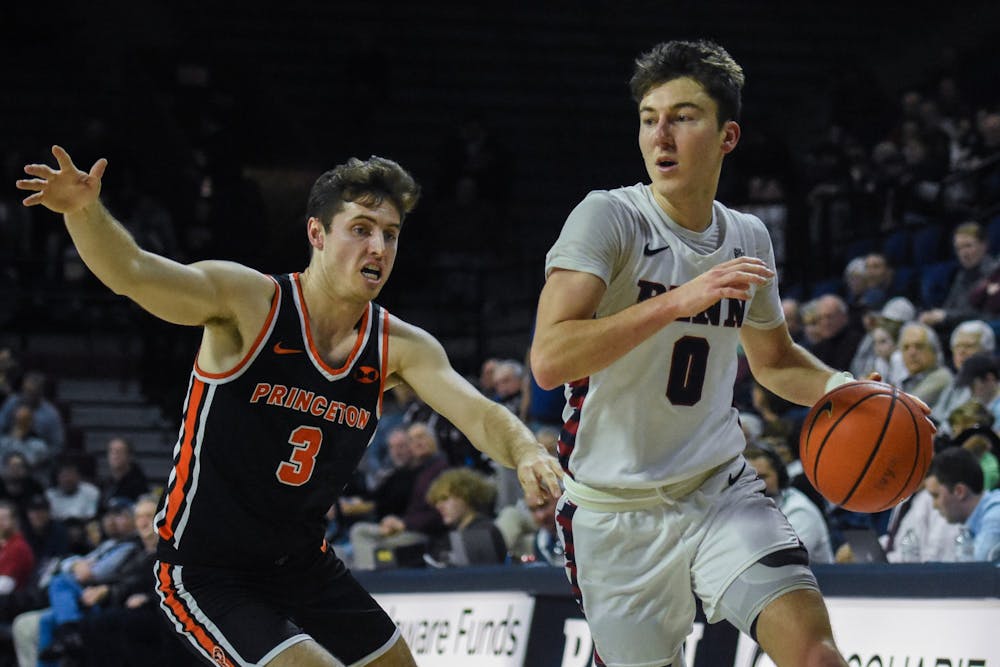
So far, Penn men’s basketball’s season has been underwhelming. There, I said it.
A team The Daily Pennsylvanian ranked first in Ivy League preseason rankings is now 2-4 against conference opponents, putting the Quakers second-to-last in the Ancient Eight with only eight games left in the season. The two wins were a 30-point blowout of cellar-dwelling Columbia and an eight-point win at middling Brown that feel like they were a lifetime ago.
Since then, against the schools most likely to represent the Ivy League in March Madness, such as current leader Princeton and last year’s champ Yale, Penn has struggled. What’s worse, the Quakers are also losing the easily winnable games, such as one at Dartmouth on Jan. 14, when Penn led by double digits well into the second half and shot a paltry 6-24 from three. Those are the games Penn needs to get into the top four of the Ivy League and make it to Ivy Madness in March.
However, despite the disappointing conference record so far, not all hope is lost for men’s basketball. Many of the reasons why the team has lost games this year seem to stem not from a talent disparity, making these flaws infinitely more fixable.
One of the largest problem areas is that Penn turns the ball over too much, as simple as that. No game shows this better than Saturday’s road bout against Yale. In the first half, Penn scored 38 points, only committed two turnovers, and cruised into halftime with a narrow three-point lead. But in the second half, the Quakers scored 25 points, turned the ball over 11 times, and ultimately lost the game by seven.
While turnovers will vary half by half and game by game, the results from Yale show that when Penn plays clean basketball, like the team did in the first half, it can go face-to-face with anyone. The question is how to play that cleanly more consistently.
One completely unsolicited suggestion for coach Steve Donahue and his staff is to run more of the offense through senior guard Lucas Monroe and senior forward Michael Moshkovitz when they are on the court. The two are currently tied for third on the team with 41 assists, and boast assist-to-turnover ratios of well over two. Moshkovitz’s stat line is especially impressive, as he has managed this in only 13.7 minutes per game, and has yet to start a game this season.
I understand that this will probably mean taking some possessions away from junior guard Jordan Dingle, and Dingle doesn’t deserve to have anything taken away from him; he’s the third-leading scorer in all of Division I and one of the most dynamic offensive players to don the Red and Blue in a long time. However, he also ranks third in the Ivy League in minutes played at 34 per game.
Dingle should not have to carry as big of an offensive workload as he does. Penn has reliable options in Monroe and senior guard Jonah Charles who can give Dingle and junior guard Clark Slajchert more time to rest and remain fresh for clutch time scenarios. Beyond their playmaking abilities, the two are also efficient scorers, with Charles shooting nearly 40% from three.
This brings us to the other reason for hope with Penn’s offense: three-point shooting. Donahue’s team has decided to determine its entire offensive performance on whether its players can make shots from deep. Over 40% of the team’s field goal attempts have been from long range. In several recent games, this has led to the Quakers dying by the three. But it also leaves room for Penn to thrive by the three.
The game against Columbia earlier this month is a great example of this. That night, Penn made 65% of its three-point attempts, en route to one of its biggest offensive performances of the season in an 84-55 win.
Of course, not every game can be against Columbia. But Penn also shot the ball well against Missouri, its toughest non-conference game this year, draining 16 of 32 threes. This strategy kept Penn within striking distance of a team that spent significant time within the AP Top 25 for most of the game.
The point here is that three-point shooting is variable. Sometimes you’re hot, sometimes you’re cold, and when Penn is hot, it can compete with anyone. Now the only hope is that the Quakers can get hot more times than not between now and March.
Just like three-point shooting, chance plays a big role in determining the fate of a college basketball season. If it can get to Ivy Madness, Penn only needs to win two single-elimination games to get a conference title and March Madness berth, which would make the 2022-23 campaign an unmitigated success. So, here’s to hoping…
The Daily Pennsylvanian is an independent, student-run newspaper. Please consider making a donation to support the coverage that shapes the University. Your generosity ensures a future of strong journalism at Penn.
Donate







